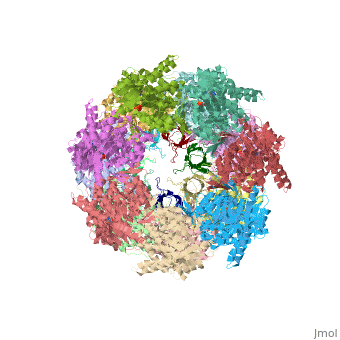1aon
From Proteopedia
| Line 4: | Line 4: | ||
==Overview== | ==Overview== | ||
| - | Chaperonins assist protein folding with the consumption of ATP. They exist | + | Chaperonins assist protein folding with the consumption of ATP. They exist as multi-subunit protein assemblies comprising rings of subunits stacked back to back. In Escherichia coli, asymmetric intermediates of GroEL are formed with the co-chaperonin GroES and nucleotides bound only to one of the seven-subunit rings (the cis ring) and not to the opposing ring (the trans ring). The structure of the GroEL-GroES-(ADP)7 complex reveals how large en bloc movements of the cis ring's intermediate and apical domains enable bound GroES to stabilize a folding chamber with ADP confined to the cis ring. Elevation and twist of the apical domains double the volume of the central cavity and bury hydrophobic peptide-binding residues in the interface with GroES, as well as between GroEL subunits, leaving a hydrophilic cavity lining that is conducive to protein folding. An inward tilt of the cis equatorial domain causes an outward tilt in the trans ring that opposes the binding of a second GroES. When combined with new functional results, this negative allosteric mechanism suggests a model for an ATP-driven folding cycle that requires a double toroid. |
==About this Structure== | ==About this Structure== | ||
| Line 14: | Line 14: | ||
[[Category: Escherichia coli]] | [[Category: Escherichia coli]] | ||
[[Category: Protein complex]] | [[Category: Protein complex]] | ||
| - | [[Category: Horwich, A | + | [[Category: Horwich, A L.]] |
| - | [[Category: Sigler, P | + | [[Category: Sigler, P B.]] |
[[Category: Xu, Z.]] | [[Category: Xu, Z.]] | ||
[[Category: ADP]] | [[Category: ADP]] | ||
| Line 22: | Line 22: | ||
[[Category: complex (groel/groes)]] | [[Category: complex (groel/groes)]] | ||
| - | ''Page seeded by [http://oca.weizmann.ac.il/oca OCA ] on | + | ''Page seeded by [http://oca.weizmann.ac.il/oca OCA ] on Thu Feb 21 11:46:46 2008'' |
Revision as of 09:46, 21 February 2008
|
CRYSTAL STRUCTURE OF THE ASYMMETRIC CHAPERONIN COMPLEX GROEL/GROES/(ADP)7
Overview
Chaperonins assist protein folding with the consumption of ATP. They exist as multi-subunit protein assemblies comprising rings of subunits stacked back to back. In Escherichia coli, asymmetric intermediates of GroEL are formed with the co-chaperonin GroES and nucleotides bound only to one of the seven-subunit rings (the cis ring) and not to the opposing ring (the trans ring). The structure of the GroEL-GroES-(ADP)7 complex reveals how large en bloc movements of the cis ring's intermediate and apical domains enable bound GroES to stabilize a folding chamber with ADP confined to the cis ring. Elevation and twist of the apical domains double the volume of the central cavity and bury hydrophobic peptide-binding residues in the interface with GroES, as well as between GroEL subunits, leaving a hydrophilic cavity lining that is conducive to protein folding. An inward tilt of the cis equatorial domain causes an outward tilt in the trans ring that opposes the binding of a second GroES. When combined with new functional results, this negative allosteric mechanism suggests a model for an ATP-driven folding cycle that requires a double toroid.
About this Structure
1AON is a Protein complex structure of sequences from Escherichia coli with and as ligands. The following page contains interesting information on the relation of 1AON with [Chaperones]. Full crystallographic information is available from OCA.
Reference
The crystal structure of the asymmetric GroEL-GroES-(ADP)7 chaperonin complex., Xu Z, Horwich AL, Sigler PB, Nature. 1997 Aug 21;388(6644):741-50. PMID:9285585
Page seeded by OCA on Thu Feb 21 11:46:46 2008

